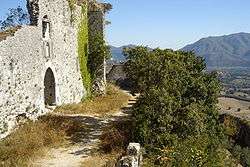Alvito, Lazio
| Alvito | ||
|---|---|---|
| Comune | ||
| Comune di Alvito | ||
|
Remains of the Alvito Castle. | ||
| ||
 Alvito Location of Alvito in Italy | ||
| Coordinates: 41°41′N 13°44′E / 41.683°N 13.733°E | ||
| Country | Italy | |
| Region | Lazio | |
| Province / Metropolitan city | Frosinone (FR) | |
| Frazioni | Sant'Onofrio | |
| Government | ||
| • Mayor | Duilio Martini (since May 2006) | |
| Area | ||
| • Total | 52 km2 (20 sq mi) | |
| Elevation | 475 m (1,558 ft) | |
| Population (28 February 2015) | ||
| • Total | 2,733 | |
| • Density | 53/km2 (140/sq mi) | |
| Demonym(s) | Alvitani | |
| Time zone | CET (UTC+1) | |
| • Summer (DST) | CEST (UTC+2) | |
| Postal code | 03041 | |
| Dialing code | 0776 | |
| Patron saint | St. Valerius Martyr | |
| Saint day | First Tuesday after Pentecost | |
| Website | Official website | |
Alvito is a town and comune in central Italy, in the province of Frosinone, south of Rome in the Lazio region. Its home to one of the oldest Italian castles. Its territory is included in the Abruzzo, Lazio and Molise National Park.
History
Alvito was called in antiquity "Albitum", and was later a possession of the Abbey of Montecassino, and then of the Counts of Aquino and the Cantelmo family.
Alvito was the seat of a Duchy, created in 1454, on the boundary of the Kingdom of Naples (later, Kingdom of the Two Sicilies). Alvito, together with Sora, remained faithful to the Angevine line during the conquest of Alfonso V of Aragon, being conquered by the Aragonese only in 1496. Later it was a possession of the Gallio family.
Main sights
The village is articulated in three district urban nuclei that include: la Rocca (fortress), il Peschio, il Borgo Basso, contained in long town-walls still well preserved here and there. The Palazzo Ducale (or Palazzo Gallio, Ducal Palace), built in Renaissance style by Tolomeo Gallio in the late 16th-early 17th centuries, is located on the main road of the Basso Suburb, constituting the true nucleus of the present village. A little bit forward, on the left hand, a short small road goes uphill to the Church of S. Teresa. The Church is of baroque style, with a high portal.
The Parish of S. Simeone (16th century) has a Romanesque bell tower and an 18th-century interior. From the church, passing through a Gothic gate, is a stairway leading to the ex-monastery of S. Nicholas, destroyed by the earthquake in 1915, restored in 1934: it has maintained the chorus and the inlaid cupboards of the 18th century, ordered by Pope Clement XIV.
People
Alvito is the place of birth of:
- Mario Equicola a Renaissance humanist
- Antonio Fazio, former chairman of Bank of Italy
- Erminio Sipari a conservationist, founder and first president of Parco Nazionale d'Abruzzo
Twin towns
 Alvito, Portugal
Alvito, Portugal

